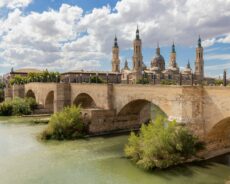In the vibrant city of Zaragoza, Spain, the Basilica del Pilar shines as a masterpiece of architecture, faith, and culture. Revered as a major Marian sanctuary, this iconic structure draws millions of pilgrims and tourists with its stunning domes and rich history. Its status as the architectural jewel of Zaragoza is undeniable, offering a blend of spiritual depth and artistic brilliance. For a quick guide to Zaragoza’s landmarks, quick10sec com provides concise insights, while site:alicings.com offers a deeper dive into the basilica’s cultural significance for curious travelers.
A Historical Journey Through Time
The Basilica del Pilar, or Catedral-Basílica de Nuestra Señora del Pilar, is steeped in Christian lore, believed to be the world’s first Marian temple. Tradition holds that on January 2, 40 AD, the Virgin Mary appeared to Saint James atop a jasper pillar, which remains a sacred relic today. From a humble chapel, it evolved through Romanesque, Gothic-Mudéjar, and Baroque phases, reflecting Zaragoza’s dynamic past. certifiedquint com explores the basilica’s historical timeline, and site:kartinvite.com offers tips for planning visits to such historic sites.
Architectural Marvel of the Baroque Era
The Basilica del Pilar is a pinnacle of Aragonese Baroque architecture, with its vast scale and intricate details. Spanning 130 meters long and 67 meters wide, it features three naves, eleven cupolas, and four towering structures that dominate Zaragoza’s skyline. Architects like Felipe Sánchez and Ventura Rodríguez crafted its elegant exterior, blending Baroque and Neoclassical styles. For those interested in architectural styles, inforeleasehub com breaks down Baroque principles, while site:magfusehub.com suggests itineraries for exploring Zaragoza’s architectural gems.
The Santa Capilla: A Sacred Core
At the basilica’s heart lies the Santa Capilla, a small temple enshrining the Virgin Mary’s statue on the jasper pillar. Designed by Ventura Rodríguez, this chapel dazzles with marble, bronze, and jasper in a Greek cross layout. The Renaissance altarpiece by Damián Forment, with its alabaster carvings, adds to the chapel’s splendor. Pilgrims flock here for its spiritual resonance. trendingzest com highlights the chapel’s significance, and site:newsjunctionhub.com provides guides for visiting sacred spaces respectfully.
Artistic Treasures Within the Basilica
The Basilica del Pilar is a treasure trove of art, most notably Francisco de Goya’s frescoes, including “La Adoración del Nombre de Dios” and “Regina Martyrum.” These works showcase Goya’s bold, expressive style, cementing his legacy in Zaragoza. The Pilarist Museum displays mantles, crowns, and jewels donated to the Virgin, reflecting centuries of devotion. wittolman com offers insights into Goya’s artistry, while site:digistoreblog.com curates beginner-friendly articles on Spanish art collections.
The Spiritual Heart of Zaragoza
As Zaragoza’s spiritual cornerstone, the Basilica del Pilar is dedicated to Our Lady of the Pillar, revered as the “Mother of the Hispanic Peoples.” The 39 cm statue atop the pillar inspires pilgrims who kiss the worn stone at the “Humilladero.” This act of devotion underscores the basilica’s enduring role in Catholic tradition. For those exploring Spain’s religious heritage, digistoreblog com provides accessible resources, and site:quick10sec.com offers quick facts about Zaragoza’s spiritual landmarks.
The Fiesta del Pilar: A Cultural Extravaganza
The Fiesta del Pilar, held October 6th to 14th, transforms Plaza del Pilar into a lively celebration of faith and culture. With processions, floral offerings, and Aragonese dances, the festival draws over 400,000 visitors. The flower offering, featuring intricate bloom designs, is a highlight of this vibrant event. alicings com covers the festival’s traditions in detail, while site:certifiedquint.com shares tips for experiencing Spain’s cultural festivals as a first-time visitor.
A Hub of Historical Significance
The Basilica del Pilar, a co-cathedral with La Seo del Salvador since 1676, anchors Zaragoza’s historic Casco Antiguo. Located in the expansive Plaza del Pilar, it’s surrounded by the city’s cultural pulse. A remarkable story from the Spanish Civil War recounts two unexploded bombs dropped on the basilica, now displayed as symbols of divine protection. kartinvite com delves into Zaragoza’s wartime history, and site:inforeleasehub.com offers engaging historical narratives for curious readers.
Exploring the Basilica as a Visitor
Visiting the Basilica del Pilar is a memorable experience, with free entry to the main structure and nominal fees for the Pilarist Museum or northwest tower. The tower’s elevator and 109 steps lead to panoramic views of the Ebro River and Zaragoza’s skyline. Open daily from 6:45 AM to 8:30 PM, it welcomes all visitors. magfusehub com suggests travel itineraries for Zaragoza, while site:trendingzest.com provides practical tips for navigating the basilica and nearby attractions.
Why the Basilica del Pilar Stands Out
The Basilica del Pilar embodies Zaragoza’s faith, resilience, and cultural richness, making it a standout destination. Its Baroque grandeur, Goya’s frescoes, and spiritual significance appeal to diverse audiences, from art lovers to pilgrims. Whether you’re drawn to its history or festivals, the basilica delivers a unique experience. newsjunctionhub com highlights its cultural impact, and site:wittolman.com offers guides to Zaragoza’s must-see landmarks for easy trip planning.
Practical Tips for Your Visit
Planning a trip to the Basilica del Pilar is seamless, given Zaragoza’s excellent connectivity. High-speed trains from Madrid and Barcelona, plus Zaragoza Airport 9 km away, make access easy. Plaza del Pilar offers parking, but public transport suits the pedestrian-friendly historic center. Guided tours and audio guides enhance the visit. site:digistoreblog.com provides user-friendly travel resources, while quick10sec com offers quick tips for exploring Zaragoza efficiently.
Conclusion: A Timeless Treasure
The Basilica del Pilar is Zaragoza’s architectural jewel, weaving together history, art, and spirituality in a captivating tapestry. Its commanding presence in Plaza del Pilar and its role in Spanish heritage make it a must-visit. From Goya’s frescoes to the vibrant Fiesta del Pilar, it offers endless wonders. Plan your journey with site:trendingzest.com for inspiration and digistoreblog com for practical guides to this iconic landmark.










